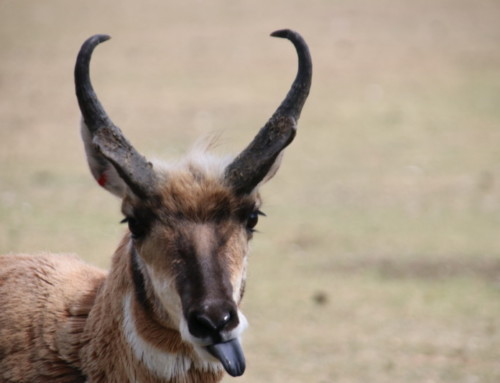The Komodo Dragon (Varanus komodoensis) by Claire Bullaro
Varanus komodoensis or the Komodo Dragon is the largest lizard in the world and is in the same family as other monitor lizards. The largest have weighed in at 165 kg and 3.1 meters in length. They are at the top of the food chain as there are no large mammals such as tigers or lions or other mammalian predators on the islands. They are carnivores, scavengers, and cannibalistic. Their habitat is tropical savannah forest with tall grasses and bushes. However they will range from lowlands to beaches to high ridges with an average home range of 1.9 square km.
Varanus and other monitor lizards have long necks with 9 cervical vertebrae (all other lizards have 8 or fewer), strong legs, long forked tongues, sharply pointed, serrated teeth, and, most likely, venom of some sort. They are good swimmers and can travel from island to island. They carry a huge variety of bacteria in their mouths without that affecting them and studies have been done on their blood to try to see just what it is that protects them from infection. It is currently believed that they also have some venom that may cause bitten prey to continue to bleed. In addition to carrion, Komodo Dragons will attack prey from the size of sheep, goats and pigs to horses, deer, and water buffalo – and other Dragons. Their hunting technique is to lie in wait until something gets close enough then lunge, grab with their formidable claws, and bite with sharp teeth. Generally anything that is attacked will be followed until it dies and then will be eventually completely eaten by the initial attacker or by others. They can eat 80% of their body weight at one feeding and 10% of their diet is young Komodo Dragons. They have an acute sense of smell and have even been known to dig up and eat buried corpses.
Males will fight for dominance and for mating rights by standing upright and wrestling. Their skin is reinforced by bony plates called osteoderms, protecting them with a kind of internal armor. Females may be slightly smaller but there is no great physical distinction between the sexes. Adults are at least five years old before they are sexually mature. Females can produce viable eggs without mating. The female will lay up to 30 eggs in the early fall to avoid the hottest season and will bury them in the earth. She may stay nearby, lying on top of the buried eggs for a time but there is no evidence of care once the eggs hatch after 8 months. As soon as the young emerge, weighing only about 100 grams, they are subject to predation by other animals including adult dragons. Those surviving will immediately head to trees and climb up. Juveniles will eat grasshoppers, eggs, beetles, geckos, birds and small mammals. When they get large enough they will begin to return to the ground as they hunt larger food and are more capable of escaping predation.
Komodos will dig a den of sorts to escape the heat of the day and shelter in at night or during rains. As with most reptiles, they cannot easily regulate their body temperature. Their preferred temperatures are in the mid-30 degree C range and high humidity. Their life span is not completely known but may be up to 30 years in the wild, much shorter in captivity. While Komodos are in important tourism draw they are listed as endangered on the CITES list due to prey depletion, human encroachment on their habitat, and poaching.

